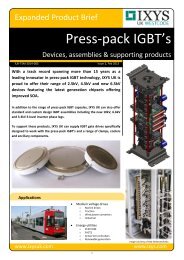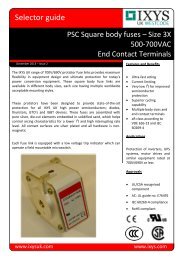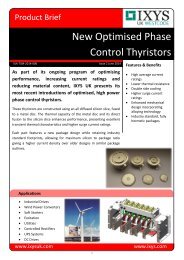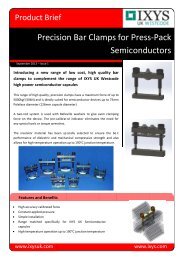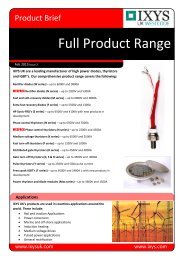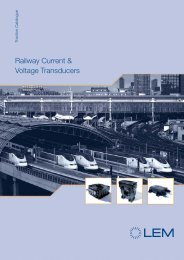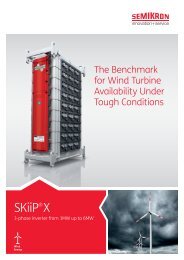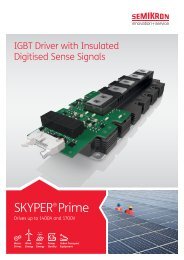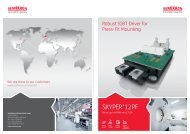industry current voltage transducers
You also want an ePaper? Increase the reach of your titles
YUMPU automatically turns print PDFs into web optimized ePapers that Google loves.
LEM’s Quality & Standards<br />
LEM’s Quality & Standards<br />
QUALITY<br />
LEM is dedicated to deliver products meeting the highest<br />
quality standards.<br />
These levels of quality may differ according to the application<br />
as well as the necessary standards to comply with.<br />
This quality has to be reached, maintained and constantly<br />
improved for both our products and services. The different<br />
LEM design and production centers around the world are<br />
ISO/TS 16949, ISO 9001 and/or ISO 14001 certified.<br />
LEM ISO/TS 16949: 2009<br />
SWITZERLAND ISO 14001: 2004<br />
ISO 9001: 2008<br />
IRIS: 2009<br />
LEM electronics ISO 9001: 2008<br />
(CHINA) Co, Ltd ISO/TS 16949: 2009<br />
ISO 14001: 2004<br />
IRIS: 2009<br />
LEM Japan ISO 9001: 2008<br />
ISO 14001: 2004<br />
TVELEM ISO 9001: 2008<br />
(RUSSIA)<br />
Several quality tools have been implemented at LEM to<br />
assess and analyze its performances. LEM utilizes this<br />
information to take the necessary corrective actions to remain<br />
a responsive player in the market.<br />
The most representative are:<br />
• DPT FMEA (Design, Process & Tool Failure Mode Effect<br />
Analysis) tool used preventively to:<br />
o identify the risks and the root causes related to the<br />
product, the process or the machinery<br />
o set up the corrective actions<br />
• Control Plan: Description of checks and monitoring actions<br />
executed along the production process<br />
• Cpk – R&R (Capability for Processes & Measurement<br />
Systems):<br />
o Cpk: Statistical tool used to evaluate the ability of a<br />
production procedure to maintain the accuracy within<br />
a specified tolerance<br />
o R&R: Repeatability and Reproducibility: Tool to monitor<br />
the accuracy of a measurement device within a predetermined<br />
tolerance<br />
• QOS – 8D (Quality Operating System – Eight Disciplines):<br />
o 8D: Problem solving process used to identify and<br />
eliminate the recurrence of quality issues<br />
o QOS: System used to solve problems<br />
• IPQ (Interactive Purchase Questionnaire): Tool aimed at<br />
involving the supplier in the quality of the purchased parts<br />
and spare parts.<br />
In addition to these quality programs, and since 2002,<br />
LEM embraces Six Sigma as its methodology in pursuit<br />
of business excellence. The main goal is to create an<br />
environment in which anything less than Six Sigma quality is<br />
unacceptable.<br />
Key Six Sigma Statistics<br />
Company<br />
Status<br />
Non<br />
Competitive<br />
Industry<br />
Average<br />
World Class<br />
Sigma<br />
Level<br />
2<br />
3<br />
4<br />
5<br />
6<br />
Defect<br />
Free<br />
65%<br />
93%<br />
99.4%<br />
99.976%<br />
99.9997%<br />
Source: Six Sigma Academy, Cambridge Management Consulting<br />
Defects Per<br />
Million<br />
308,537<br />
66,807<br />
6,210<br />
233<br />
3.4<br />
LEM’s Standards<br />
LEM <strong>transducers</strong> for Industry and traction are designed and<br />
tested according to recognized worldwide standards.<br />
CE marking is a guarantee that the product<br />
complies with the European EMC directive<br />
2004/108/EEC and low <strong>voltage</strong> directive and<br />
therefore warrants the electromagnetic compatibility of the<br />
<strong>transducers</strong>. Traction <strong>transducers</strong> comply to the EN 50121-3-<br />
2 standard (Railway EMC standard).<br />
UL is used as a reference to define the flammability<br />
of the materials used for LEM products (UL94V0)<br />
as well as the NFF 16101 and 16102 standards fot<br />
the fire/smoke materials classification when <strong>transducers</strong><br />
dedicated for traction applications.<br />
LEM is <strong>current</strong>ly UL recognized for key products. You can<br />
consult the UL website to get the updated list of recognized<br />
models at www.UL.com.<br />
The EN 50178 standard dedicated to “Electronic Equipment<br />
for use in power installations” in industrial applications is<br />
our standard of reference for electrical, environmental and<br />
mechanical parameters.<br />
It guarantees the overall performances of our products in<br />
industrial environments.<br />
All of the LEM Industry products are designed according<br />
to the EN 50178 standard except if dedicated to railway<br />
applications.<br />
In that case, the EN 50155 standard dedicated to “Electronic<br />
Equipment used on Rolling stock” in railway applications is<br />
our standard of reference for electrical, environmental and<br />
mechanical parameters.<br />
It guarantees then the overall performances of our products in<br />
railway environments.<br />
All of the LEM traction products are designed according to<br />
the EN 50155 standard.<br />
The individual data sheets precisely specify the applicable<br />
standards, approvals and recognitions for individual products.<br />
The EN 50178 standard is also used as reference to design<br />
the creepage and clearance distances for the <strong>transducers</strong><br />
versus the needed insulation levels (rated insulation <strong>voltage</strong>)<br />
and the conditions of use.<br />
The rated insulation <strong>voltage</strong> level for <strong>transducers</strong> in<br />
“industrial” applications, is defined according to several<br />
criteria listed under the EN 50178 standard and IEC 61010-1<br />
standard (“Safety requirements for electrical equipment for<br />
measurement, control and laboratory use”). Some criteria are<br />
dependent on the transducer itself when the others are linked<br />
to the application.<br />
These criteria are the following:<br />
• Clearance distance (the shortest distance in air between<br />
two conductive parts)<br />
• Creepage distance (the shortest distance along the surface<br />
of the insulating material between two conductive parts)<br />
• Pollution degree (application specific - this is a way to<br />
classify the micro-environmental conditions having effect<br />
on the insulation)<br />
• Over-<strong>voltage</strong> category (application specific - characterizes<br />
the exposure of the equipment to over-<strong>voltage</strong>s)<br />
• Comparative Tracking Index (CTI linked to the kind of<br />
material used for the insulated material) leading to a<br />
classification over different Insulating Material groups<br />
• Simple (Basic) or Reinforced isolation need<br />
LEM follows this thought process for all the transducer<br />
designs:<br />
Example: LTSP 25-NP, <strong>current</strong> transducer in a motor drive.<br />
Conditions of use:<br />
Creepage distance (on case): 12.3 mm<br />
Clearance distance (on PCB, footprint as above figure as an<br />
example): 6.2 mm<br />
CTI: 175 V (group IIIa)<br />
Over-<strong>voltage</strong> category: III<br />
Pollution Degree: 2<br />
Basic or Single insulation<br />
According to EN 50178 and IEC 61010-1 standards:<br />
With clearance distance of 6.2 mm and PD2 and OV III, the<br />
rated insulation <strong>voltage</strong> is of 600 V RMS<br />
.<br />
With a creepage distance of 12.3 mm and PD2 and CTI of 175<br />
V (group IIIa), this leads to a possible rated insulation <strong>voltage</strong><br />
of 1000 V RMS<br />
.<br />
In conclusion, the possible rated insulation <strong>voltage</strong>, in these<br />
conditions of use, is 600 V RMS<br />
(the lowest value given by the<br />
both results from the creepage and clearance distances).<br />
Reinforced insulation<br />
Let’s look at the reinforced insulation for the same creepage<br />
and clearance distances as previously defined:<br />
When looking at dimensioning reinforced insulation, from the<br />
clearance distance point of view, with OV III and according<br />
to EN 50178 and IEC 61010-1 standards, the rated insulation<br />
<strong>voltage</strong> is given whatever the pollution degree at 300 V RMS<br />
.<br />
From the creepage distance point of view, when dimensioning<br />
reinforced insulation, the creepage distance taken into<br />
account has to be the real creepage distance divided by 2,<br />
that is to say 12.3 / 2 = 6.15 mm.<br />
With that value, and PD2 and CTI of 175 V (group IIIa), this<br />
leads to a possible rated insulation <strong>voltage</strong> of 500 V . RMS<br />
In conclusion, the possible reinforced rated insulation <strong>voltage</strong>,<br />
in these conditions of use, is of 300 V RMS<br />
(the lowest value<br />
given by the both results from the creepage and clearance<br />
distances).<br />
For railway applications, the EN 50124-1<br />
(“Basic requirements - Clearances and creepage distances<br />
for all electrical and electronic equipment”) standard is used<br />
as reference to design the creepage and clearance distances<br />
for the <strong>transducers</strong> versus the needed insulation levels (rated<br />
insulation <strong>voltage</strong>) and the conditions of use.<br />
The rated insulation <strong>voltage</strong> level allowed by a transducer<br />
intended to be used in an application classified as being<br />
“Railway”, is defined according to several criteria listed under<br />
the EN 50124-1 standard.<br />
These criteria are the same as per the EN 50178 (seen<br />
previously) and are the following:<br />
- Clearance distance,<br />
- Creepage distance,<br />
- Pollution degree,<br />
- Over-<strong>voltage</strong> category,<br />
- Comparative Tracking Index (CTI),<br />
- Simple (Basic) or Reinforced isolation need.<br />
LEM follows this thought process for the railway transducer<br />
designs:<br />
Example: LTC 600-S, <strong>current</strong> transducer in an propulsion<br />
inverter<br />
Conditions of use:<br />
Creepage distance: 66.70 mm,<br />
Clearance distance: 45.90 mm,<br />
CTI: 600 V (group I),<br />
Over-<strong>voltage</strong> category: II,<br />
Pollution Degree: 3.<br />
QUALITY<br />
70<br />
71





